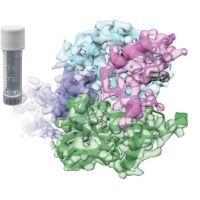Specification
| Organism | Homo sapiens (Human) |
| Expression Host | E.coli |
| Tag Info | N-terminal 6xHis-tagged |
| Purity | Greater than 85% by SDS-PAGE |
| Uniprot ID | P48023 |
| Gene Names | FASLG |
| Alternative Names | Apoptosis antigen ligand ;APTLCD95 ligand ;CD95-LFas antigen ligand ;Fas ligand ;FasL; CD178 |
| Expression Region | Extracellular Domain(103-281aa ) |
| Molecular Weight | 24.4 kDa |
| Protein Sequence | QLFHLQKELAELRESTSQMHTASSLEKQIGHPSPPPEKKELRKVAHLTGKSNSRSMPLEWEDTYGIVLLSGVKYKKGGLVINETGLYFVYSKVYFRGQSCNNLPLSHKVYMRNSKYPQDLVMMEGKMMSYCTTGQMWARSSYLGAVFNLTSADHLYVNVSELSLVNFEESQTFFGLYKL |
| Form | Liquid or Lyophilization |
| Buffer | The default storage buffer is Tris/PBS-based buffer, 5%-50% glycerol if the delivery form is liquid. The lyophilization buffer is Tris/PBS-based buffer, 6% Trehalose, pH 8.0 if the delivery form is lyophilized powder. Please contact us if you have any special requirment. |
| Reconstitution | Please reconstitute protein in deionized sterile water and we recommend that briefly centrifuge thevial prior to opening the vial .We recommend aliquot for long-term storage at -20℃/-80℃. |
Background
| Relevance | Cytokine that binds to TNFRSF6/FAS, a receptor that transduces the apoptotic signal into cells. May be involved in cytotoxic T-cell mediated apoptosis and in T-cell development. TNFRSF6/FAS-mediated apoptosis may have a role in the induction of peripheral tolerance, in the antigen-stimulated suicide of mature T-cells, or both. Binding to the decoy receptor TNFRSF6B/DcR3 modulates its effects. |
| Involvement in Disease | Autoimmune lymphoproliferative syndrome 1B (ALPS1B) |
| Subcellular Location | Cell membrane, Single-pass type II membrane protein, Cytoplasmic vesicle lumen, Lysosome lumen, Note=Is internalized into multivesicular bodies of secretory lysosomes after phosphorylation by FGR and monoubiquitination (PubMed:17164290), Colocalizes with the SPPL2A protease at the cell membrane (PubMed:17557115), SUBCELLULAR LOCATION: Tumor necrosis factor ligand superfamily member 6, soluble form: Secreted, Note=May be released into the extracellular fluid by cleavage from the cell surface, SUBCELLULAR LOCATION: FasL intracellular domain: Nucleus |
| Protein Families | Tumor necrosis factor family |
| Tissue Specificity | FASLG |
QC Data
| Note | Please contact us for QC Data |
| Product Image (Reference Only) |  |

